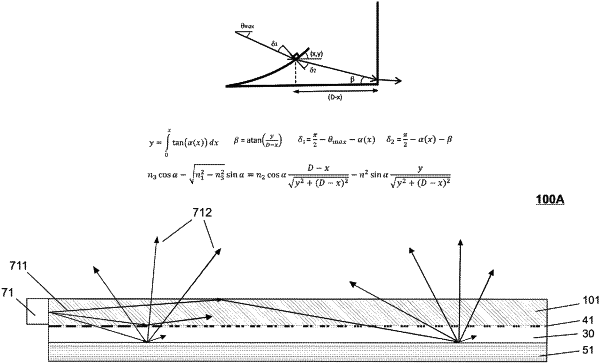| CPC G02B 6/0036 (2013.01) [G02B 5/0247 (2013.01); G02B 6/0023 (2013.01); G02B 6/0031 (2013.01); G02B 6/0043 (2013.01); G02B 6/0055 (2013.01); G02B 6/0063 (2013.01); G02B 6/002 (2013.01); G02B 6/4243 (2013.01); G02B 6/4259 (2013.01); G09F 2013/1804 (2013.01)] | 38 Claims |

|
1. A transparent optical device comprising:
a lightguide medium configured for light propagation; and
an at least one optically functional layer comprising at least one optically functional feature pattern formed in a light-transmitting carrier medium by a plurality of embedded features provided as optically functional internal cavities,
wherein the at least one feature pattern is configured to perform an incident light control function and at least a light outcoupling function by establishing a predetermined incoupled light distribution at the at least one feature pattern and/or by modifying refractive indices of materials and elements provided in the optical device and interfaces therebetween, whereby stray light is minimized and optical transparency of the device is established,
wherein the cavities in the at least one feature pattern comprise an entrance surface and an exit surface, wherein the entrance surface is configured to incouple incident light rays arriving thereat and to direct light rays into a respective one of the cavities towards the exit surface, and wherein the exit surface is configured to receive light rays arriving thereat and to transmit light rays arriving thereat outside the respective one of the cavities into the light-transmitting carrier medium for propagation and/or for outcoupling,
wherein the entrance surface is further configured to incouple light rays arriving thereto with a collimation function and to direct light rays into the respective one of the cavities such that light rays arriving thereto at a predetermined angle of incidence or a range of angles of incidence propagate through the respective one of the cavities and hit and exit an exit surface while avoiding hitting any other surface including a bottom surface that extends between the entrance surface and the exit surface,
the entrance surface is further configured to incouple light rays arriving thereto at the predetermined angle of incidence or a range of angles of incidence smaller than a critical angle relative to the surface normal, whereby outcoupled Fresnel reflection is avoided,
wherein a maximum angle of incidence of the predetermined angle of incidence or the range of angles of incidence is defined by: θmax=acos(n3/n1),
the entrance surface includes, at least partially, a curved surface or a non-linear surface such that light rays incident on the entrance surface at the maximum angle of incidence do not hit the bottom surface, and
wherein n3 is a refractive index of an external medium outside the lightguide and n1 is a refractive index of the light-transmitting carrier medium.
|